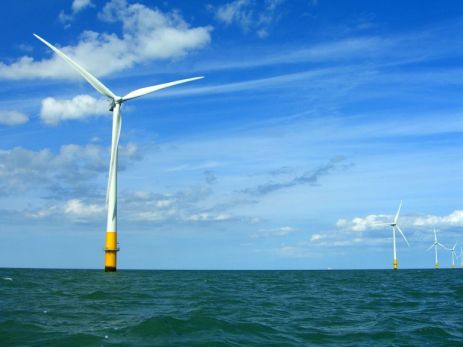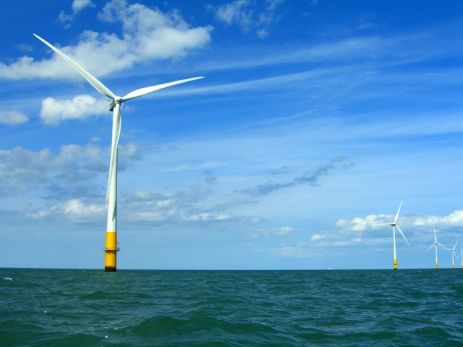 Offshore wind turbinePhoto courtesy phault via FlickrWhen Interior Secretary Ken Salazar announced federal approval of the Cape Wind project on Wednesday, the media coverage tended to focus on the denouement of a nearly decade-long battle over the United States’ first offshore wind farm.
Offshore wind turbinePhoto courtesy phault via FlickrWhen Interior Secretary Ken Salazar announced federal approval of the Cape Wind project on Wednesday, the media coverage tended to focus on the denouement of a nearly decade-long battle over the United States’ first offshore wind farm.
And indeed, our East Coast cousins put Californians to shame when it comes to green NIMBYism. (Not to dismiss legitimate environmental concerns over offshore wind farms, but the nine-year struggle to put 130 wind turbines in the Kennedy’s backyard in Nantucket Sound makes the permitting of Mojave Desert solar power plants look like a breeze by comparison.)
The fight over Cape Wind isn’t over yet — the project still needs to obtain approval from other agencies, and opponents are likely to mount legal challenges.
But what struck me is that the Obama administration’s move marks the emergence of an East Coast renewable energy industry that will help nationalize the transition to green power. To be sure, there are wind farms, solar installations, and biomass plants east of the Mississippi. But Big Green power has largely been a phenomenon of the West Coast and the Great Plains, regions rich in wind and sunshine.
Plans to build massive solar power plants and turbine farms have spawned a renewable energy infrastructure of investors, bankers, utilities, manufacturers, and a nascent green workforce of builders and technicians. In other words, a political constituency to push for favorable state and federal tax incentives, renewable energy standards and climate change legislation.
Putting aside profound ideological differences, the failure of Congress to pass climate change legislation and the interminable haggling boils down to regionalism — coal states versus natural gas, wind, and solar states. Just witness the willingness of Texas oil companies to bankroll a California ballot initiative that would put the Golden State’s landmark global warming law on hold. (Texas is becoming big wind state, but as a huge oil state it retains a much bigger stake in fossil fuels.)
Now imagine the potential consequences of the federal government’s approval of Cape Wind.
“This will be the first of many projects up and down the Atlantic coast which I expect will come online in the years ahead as we build a new energy future for our country,” Salazar said at a press conference in Boston on Wednesday.
There are currently proposals to build nearly 2,500 megawatts’ worth of offshore wind farms from Massachusetts to North Carolina, according to the American Wind Energy Association. Other developers want to put wind farms off the Texas coast and in the Great Lakes.
Given that such wind farms would be close to major East Coast population centers, there’d be no need to construct long-distance transmission lines, which would avoid some costly environmental and political battles. (Though putting such lines under water comes with its own high costs and environmental considerations.)
A series of Cape Wind-sized turbine farms — each generating, at peak output, the electricity of a mid-sized coal-fired power plant — would also create thousands of construction and maintenance jobs and put the U.S. in a position to compete in the massive megawatt offshore market now dominated by European companies and countries, with China not far behind.
Silicon Valley venture capitalists have shied away from investing in wind, viewing it as a relatively “mature” industry that doesn’t offer many opportunities for technological disruption, the potential to upend an industry and make a lot of money. (Plus, wind farms are impractical off the California coast due to the depth of the ocean and the need to build floating platforms for the turbines.)
But the rise of offshore wind appears to be changing this thinking.
Offshore turbine farms can tap stronger and more consistent winds and thus generate more electricity. But they currently do so at up to twice the cost of land-based installations. That’s due to the expense of building and maintaining wind farms in deep water and constructing turbines that can withstand rough seas, high winds, and corrosion.
Enter the VCs. To minimize those costs and create economies of scale, companies like Vestas and Clipper Windpower are developing massive turbines that can generate up to 10 megawatts each. (Most land-based turbines generate one to 2.5-megawatts.)
That means there’s opportunities as well for startups engineering advanced gearboxes capable of operating gigantic turbines, motors and other materials, according to Jim Kim, a partner at Khosla Ventures, one of Silicon Valley’s leading green tech venture capital firms.
Kim was on a panel I moderated Tuesday at Nordic Green, a conference held at SRI International in Menlo Park, Calif., that brings together Silicon Valley venture capitalists with entrepreneurs from Scandinavia, a region that knows a thing or two about Big Wind.
Khosla Ventures has invested in Danotek Motion Technologies, a Michigan startup that makes generators and other components for wind turbines. The firm also participated in a round of funding for Nordic Windpower, a Berkeley, Calif.-based company that is developing new designs for wind turbines that promise to cut their capital costs and maintenance expenses.
“We’re taking a new look at wind,” said Kim. “There’s opportunities in a space we have not previously played.”
The winds of change are blowing from the East for a change.



